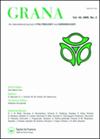阿尔及利亚Laghouat地区蜂蜜花粉分析
IF 1
4区 生物学
Q4 PLANT SCIENCES
引用次数: 1
摘要
摘要对Laghouat地区不同地点采集的41份蜂蜜样品进行了显微分析,发现存在48科98种花粉类型。所有样品中均含有菊科、豆科和硝子科。在80%以上的样品中鉴定出芸苔科、鼠李科和蜂科。花粉类型多样性最高的科为豆科和菊科,分别有13种和11种,蜂科和菖蒲科各有5种。单花蜜27份(65.85%),多花蜜14份。主要花粉类型为紫花莲、山楂、紫堇、柽柳、荷花、桉树、紫果和甘薯。18种花粉类型被归类为非常常见,存在于50%以上的样品中。每个样品鉴定出的花粉类型在14 ~ 40种之间,平均为24.41种。在定量分析中,所研究蜂蜜样品的花粉含量从中等(II类,占样品的48.78%)到高(III类,占样品的53.65%),其中10 g蜂蜜的花粉密度在26 607 ~ 660 992之间,平均每10 g蜂蜜的花粉密度为160 880粒。本文章由计算机程序翻译,如有差异,请以英文原文为准。
Pollen analysis of honey from Laghouat region (Algeria)
Abstract
A microscopic analysis of 41 samples of honey obtained from several locations in the Laghouat region revealed the presence of 98 pollen types belonging to 48 families. Asteraceae, Fabaceae and Nitrariaceae were present in all the samples. Brassicaceae, Rhamnaceae and Apiaceae were identified in more than 80% of the samples. The families with highest diversity of pollen types were Fabaceae and Asteraceae with 13 and 11 types, respectively, Apiaceae and Boraginaceae with five types each. Twenty-seven honey samples (65.85%) were found to be monofloral and the remaining 14 polyfloral. The pollen types from Ziziphus lotus, Peganum harmala, Echium sp., Tamarix sp., Lotus, Eucalyptus sp., Eruca vesicaria and Thapsia garganica appeared as the predominant pollen. Eighteen pollen types were classified as very frequent, present in more than 50% of the samples. The number of pollen types identified per sample ranged between 14 and 40 (mean of 24.41). For the quantitative analysis, the pollen content of the studied honey samples ranged from medium (class II, 48.78% of the samples) to high (class III, 53.65% of the samples), where the pollen density ranged from 26 607 to 660 992 in 10 g of honey, with an average of 160 880 grains per 10 g.
求助全文
通过发布文献求助,成功后即可免费获取论文全文。
去求助
来源期刊

Grana
生物-植物科学
CiteScore
2.10
自引率
11.10%
发文量
23
审稿时长
>12 weeks
期刊介绍:
Grana is an international journal of palynology and aerobiology. It is published under the auspices of the Scandinavian Palynological Collegium (CPS) in affiliation with the International Association for Aerobiology (IAA). Grana publishes original papers, mainly on ontogony (morphology, and ultrastructure of pollen grains and spores of Eucaryota and their importance for plant taxonomy, ecology, phytogeography, paleobotany, etc.) and aerobiology. All submitted manuscripts are subject to initial appraisal by the Editors, and, if found suitable for further consideration, to peer review by independent, anonymous expert referees. All peer review is single blind and submission is online via ScholarOne Manuscripts.
 求助内容:
求助内容: 应助结果提醒方式:
应助结果提醒方式:


